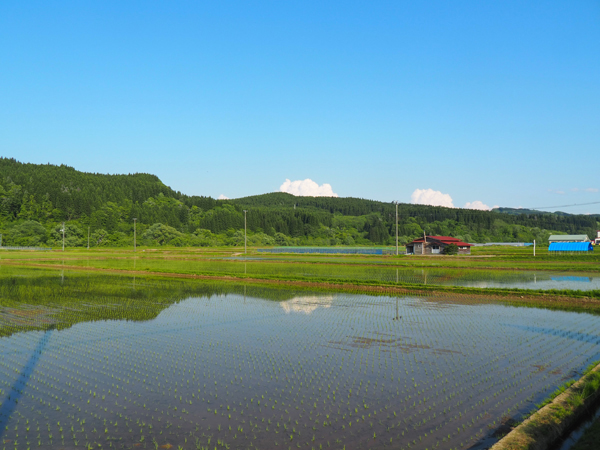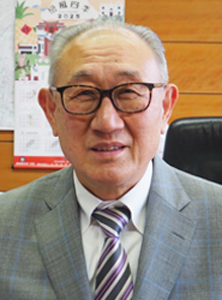Series “Visiting Villages” 23 Kamikoani Village, Akita, creating new industries centered on forestry, including natural Akita cedar


小林村長(Mayor Kobayashi)
Kamikoani Village is the smallest municipality in Akita Prefecture, with a population of about 1,700. Mountains make up 90% of the total area. DX is relatively advanced, and autonomous driving services are being rolled out within the village. They are also focusing on creating new industries, and are promoting new businesses centered on forestry. (Kei Kitajima)
Kamikoani Village is a village surrounded by forests, located about an hour’s drive from Akita City. The population is about 1,700, and the aging rate is 55%. It is the smallest municipality in Akita Prefecture, and the aging rate is the highest in the prefecture.
On the other hand, DX is relatively advanced. This is because 12 towns and villages in the prefecture have formed the “Akita Prefecture Town and Village Computer System Joint Business Association,” unifying the administrative information systems that each town and village had previously operated independently. The 12 towns and villages also jointly use the Government Cloud.
In terms of DX, the village is also providing the self-driving service “Koani Car.”
Mayor Kobayashi Etsuji explains, “Our goal is to provide transportation for the elderly who have given up their driver’s licenses. The elderly cannot go out without transportation. Not going out is a risk to their physical and mental health. We are running self-driving buses as a means to prevent this.”
The NPO Kamikoani Village Transportation Service Association operates the bus with “conditional automated driving” (level 3). Since it is level 3, there is a driver in the driver’s seat. Also, at the moment, lines are embedded in the road and the bus runs on them. It is similar to a golf cart.
In the future, the village hopes to consolidate the self-driving bus and other transportation services provided in the village under an NPO, and is currently working on establishing a system for this.
Kamikoani Village’s core industries are agriculture and forestry.
In terms of agriculture, the village is famous for producing “Akita Komachi” rice. Currently, the village is also focusing on exporting rice, exporting it to the United States and other countries.
Mayor Kobayashi said, “It’s rare to see a region that promotes rice exports. We started two years ago, and we’ve been increasing production every year.” However, he is concerned about the future due to the Trump administration’s tariff policy and other factors.
Specialty products include edible ground cherries, kohaze (a type of blueberry), and eggplant. Demand is high, and they are processed and sold as beer, juice, jam, etc.
Like other regions, Kamikoani Village is also facing a problem of a decrease in the number of people working in agriculture. For this reason, they are currently redeveloping farmland. This is because, with the decrease in farmers, farmland is now fragmented. In other words, Mr. A’s farmland is here and there, and Mr. B’s farmland is here and there, and the land is in exclaves, making management complicated.
For example, Mr. A is planting rice, but his neighbor, Mr. B, is leaving it fallow. The problem is water management. Mr. A needs water, but Mr. B doesn’t need water because he has to dry out his rice field. If one farmer covers one large plot, these problems will be solved. Travel will be reduced, water management will be easier, and electricity costs for pumping water will be reduced. “If we exchange farmland and redevelop farmland, it will save a lot of labor, so I would like to work it out,” says Mayor Kobayashi.
From the perspective of employment, the village is also focusing on creating new industries.
“I want to start with what our village has in abundance, what we can only have,” says Mayor Kobayashi.
Mountains make up 90% of the village’s total area. Natural Akita cedar is particularly famous, and at its peak, people working in forestry accounted for 10% of the population. Currently, the cedar trees planted after the war are due for felling.
Mayor Kobayashi says, “I would like to bring together businesses in the village and make it possible to carry out a one-stop process from felling cedar to building houses.”
For example, he envisions receiving an order for a house from Tokyo, transporting cedar and other materials to Tokyo and assembling the house there.
In recent years, disasters have become more severe, but Kamikoani Village has faced heavy rain disasters for three consecutive years. It suffered damage from the “Yamagata-Akita Heavy Rains” in 2024, the “July 2023 Heavy Rains,” and the “August 2022 Heavy Rains” in 2022.
“Last year’s heavy rains caused damage of about 2 billion yen. The cause was landslides caused by heavy rains, which caused trees from the mountains to flow into the area. If the mountains are properly maintained, such as by thinning, landslides will decrease. If you cut down trees on the mountains, you should always reforest them, mow the grass, and maintain the mountains by thinning and thinning, which will lead to decarbonization and make mountain management viable,” (Mayor Kobayashi).
When heavy rains occur, the Koani River floods. During the heavy rains in July 2023, heavy rain fell on Mount Ohira, which is adjacent to Akita City and Kamikoani Village, and residential areas in Akita City were flooded by heavy flooding. Due to the emergency release of water from Hagigata Dam, all the villagers of Kamikoani were forced to evacuate to Kamikoani Elementary and Junior High School, which is located on higher ground, for the night.
“If Hagigata Dam had not existed, the damage would have been even greater. If there had been another dam, we might not have had to evacuate. That’s why we are asking the national government to build a new disaster prevention dam,” said Mayor Kobayashi.
They are also considering hydroelectric power generation, which would utilize the large amounts of water that flows in during heavy rains. Water and electricity shortages are problems during disasters. Without electricity, you can’t eat or take a bath. You can’t use the television or air conditioner. If the village can generate electricity, it will lead to disaster prevention measures.
Securing doctors is difficult in depopulated areas, but Kamikoani has a full-time doctor. In addition, Kitaakita City, Noshiro City, Odate City, and other cities are nearby, and there are many hospitals within 30 minutes by car.
A doctor from Akita City comes to the village on Mondays to provide urological care, and a doctor from Hirosaki University comes to the village on Tuesdays and Wednesdays to provide dental care.
In that sense, it is in a more favorable environment than other depopulated areas.
However, when you search for “Kamikoani Village” on the Internet, negative words such as “a village that bullies doctors” and “an evil village” stand out.
In fact, a small discrepancy was exaggerated, which caused an online uproar, and the village was labeled without justification. This is a typical example of reputational damage.
One example was in 2019. When villagers went to the clinic by minibus, they found out that the doctor had contracted influenza and could not come into contact with patients. However, the villagers had already come to the clinic. Moreover, most of the villagers were not there to be examined, but to get medicine that they usually take as needed.
The doctor’s home is adjacent to the clinic. So the doctor wrote prescriptions while communicating with a nurse at the clinic over the phone and gave the medicine to the villagers. This caused a small fuss as the “non-examination prescription problem.” Since the COVID-19 pandemic, the law has been revised to make this a non-problematic practice, but before the COVID-19 pandemic, it was problematic.
“The villagers take the trouble to get on the bus to come to the clinic. We thought it was a good idea because they would be in trouble if they didn’t have medicine and it would be a hassle to go to another hospital, but it was a problem under the Medical Care Act. There was a doctor nearby and a nurse was taking care of them, so at the time I thought it would be okay, but I was too naive,” recalls Mayor Kobayashi.
The village also had a new doctor come to the village after the resident doctor retired. The new doctor had a strong sense of mission to help the people living deep in the mountains. However, in reality, the nearby hospital is easily accessible and the villagers regularly go to other hospitals. The doctor seemed to be dissatisfied, thinking, “Why would they go to another hospital when I’m here?”
Facts like these were misinterpreted, and before we knew it, rumors had spread that the village was a “village that bullies doctors” and a “village that is evil.”
Mayor Kobayashi said, “The children in the village are heartbroken by the rumors, and we want to do something about it. As a village, we are trying to convey the facts properly, but they are not easily absorbed online. We considered using a rumor prevention service, but in the end, it would just be a cat-and-mouse game with malicious articles. For now, we are trying to overcome the damage caused by rumors by steadily conveying the facts and actively promoting the good things about Kamikoani Village”.
※Translating Japanese articles into English with AI
